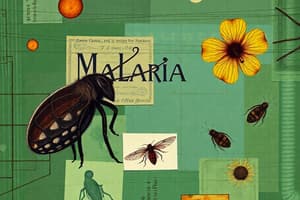Podcast
Questions and Answers
What is the most effective available therapeutic combination for treating a certain disease?
What is the most effective available therapeutic combination for treating a certain disease?
- Clarithromycin plus cotrimoxazole
- Pyrimethamine plus sulfadiazine (correct)
- Azithromycin plus sulfadiazine
- Atovaquone plus dapsone
Why should antiparasitic agents be stopped only after steroids have been stopped?
Why should antiparasitic agents be stopped only after steroids have been stopped?
- To prevent the rapid spread of tachyzoites and widespread retinitis (correct)
- To reduce the risk of allergic reactions
- To ensure the complete elimination of the parasite
- To prevent an immunodeficiency state
What is the primary purpose of using prednisone in the treatment of this disease?
What is the primary purpose of using prednisone in the treatment of this disease?
- To reduce the risk of allergic reactions
- To limit inflammatory damage (correct)
- To prevent the spread of tachyzoites
- To eliminate the parasite
What should be avoided to prevent the transmission of a certain disease?
What should be avoided to prevent the transmission of a certain disease?
Why should hands be washed after touching raw meat?
Why should hands be washed after touching raw meat?
What should be done when gardening or handling soil to prevent the transmission of a certain disease?
What should be done when gardening or handling soil to prevent the transmission of a certain disease?
What should be washed to prevent the transmission of a certain disease?
What should be washed to prevent the transmission of a certain disease?
Why should contact with cat feces be avoided?
Why should contact with cat feces be avoided?
What is the primary purpose of using azithromycin, clarithromycin, atovaquone, dapsone, and cotrimoxazole in the treatment of this disease?
What is the primary purpose of using azithromycin, clarithromycin, atovaquone, dapsone, and cotrimoxazole in the treatment of this disease?
What should be avoided when taking oral corticosteroids without antibiotic coverage?
What should be avoided when taking oral corticosteroids without antibiotic coverage?
Flashcards are hidden until you start studying
Study Notes
Toxoplasmosis
- Caused by infection with the protozoan Toxoplasma gondii, an obligate intracellular parasite.
- Only 10-20% of toxoplasmosis cases in adults and children are symptomatic.
- Toxoplasmosis is a serious and often life-threatening disease in immunodeficient patients.
- Congenital toxoplasmosis may manifest as a mild or severe neonatal disease, with onset during the first month of life or with relapse of a previously undiagnosed infection at any time during infancy or later in life.
Life Cycle of Toxoplasma gondii
- T. gondii has two distinct life cycles: the sexual cycle occurs only in cats, the definitive host, and the asexual cycle occurs in other mammals (including humans) and various strains of birds.
- The asexual cycle consists of two forms: tachyzoites (the rapidly dividing form observed in the acute phase of infection) and bradyzoites (the slowly growing form observed in tissue cysts).
Transmission
- T. gondii oocysts, tachyzoites, and bradyzoites can cause infection in humans.
- The tissue cysts are up to 60μm in diameter, each containing up to 60,000 organisms.
- Extracellular tachyzoites are cleared from host tissues, and intracellular parasites differentiate into occult bradyzoite forms.
Changes in T-Lymphocyte Levels
- Alterations in subpopulations of T lymphocytes are profound and prolonged during acute acquired T. gondii infection.
- These have been correlated with disease syndromes but not with disease outcome.
Retinochoroiditis
- Retinochoroiditis usually results from reactivation of congenital infection, although cases have been recorded that were part of acute infection.
- There are five hypotheses related to the inflammatory process of ocular toxoplasmosis.
Signs and Symptoms
- In immunocompetent personnel:
- Cervical lymphadenopathy
- Fever, malaise, night sweats, and myalgias
- Sore throat
- Retroperitoneal and mesenteric lymphadenopathy with abdominal pain
- Retinochoroiditis
- In immunodeficient patients:
- CNS toxoplasmosis occurs in 50% of patients
- Seizure, dysequilibrium, cranial nerve deficits, altered mental status, focal neurologic deficits, headache
- Encephalitis, meningoencephalitis, or mass lesions
- Hemiparesis and seizures have been reported
- Visual changes
Congenital Toxoplasmosis
- This is most severe when maternal infection occurs early in pregnancy.
- 15-55% of congenitally infected children do not have detectable T. gondii –specific IgM antibodies at birth or early infancy.
- Approximately 67% of patients have no signs or symptoms of infection.
- Retinochoroiditis occurs in about 15% of patients, and intracranial calcifications develop in 10%.
Ocular Toxoplasmosis
- Patients develop retinochoroiditis (focal necrotizing retinitis).
- Symptoms include:
- Impaired vision - Either sudden or gradual, depending on the site of infection
- Blurred vision
- Scotoma
- Pain
- Photophobia
- Floaters
- Red eye
- Metamorphopsia
Diagnosis
- Direct detection of T. gondii organisms in blood, body fluids, or tissue using PCR.
- Indirect detection of immunoglobulin G (IgG) is possible within 2 weeks of infection using ELISA test.
- Diagnostic procedures:
- Lumbar puncture
- Brain biopsy
- Lymph node biopsy
- Amniocentesis
Treatment
- Act primarily against the tachyzoite form of T. gondii; thus, they do not eradicate the encysted form (bradyzoite).
- Pyrimethamine is the most effective agent.
- Leucovorin (ie, folinic acid) should be administered concomitantly to prevent bone marrow suppression.
Prevention
- Avoid eating raw meat, unpasteurized milk, and uncooked eggs, oysters, clams, and mussels.
- Wash hands after touching raw meat.
- Wear gloves when gardening or handling soil and wash hands afterwards.
- Wash fruits and vegetables.
- Avoid contact with cat feces.
Studying That Suits You
Use AI to generate personalized quizzes and flashcards to suit your learning preferences.




